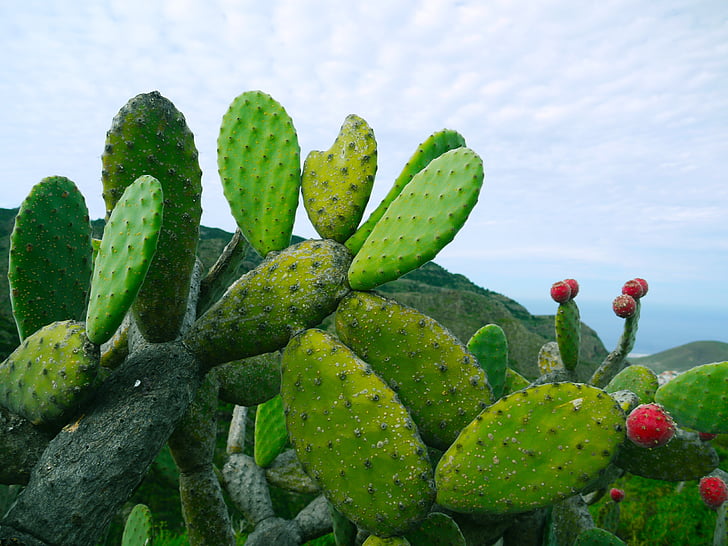About the prickly pear cactus
The prickly pear cactus (Opuntia) is a genus of cacti native to the Americas. It is also known as nopal, paddle cactus, or tuna cactus.
Prickly pear cacti are characterized by their flat, paddle-shaped stems. The stems are covered in sharp glochids (small spines).
The fruit of the prickly pear cactus is called a tuna, and it is edible.
Prickly pear cacti are found in a wide range of habitats, from deserts to forests. They are particularly well-adapted to dry environments, and they can survive for long periods of time without water.
Nutritional composition of prickly pear cactus
Prickly pear cactus is a nutritious food that is low in calories and fat. It is a good source of fiber, vitamins, and minerals.
Here is the nutritional composition of one cup (149 grams) of raw prickly pear cactus:
- Calories: 61
- Protein: 1 gram
- Fat: 1 gram
- Carbohydrates: 14 grams
- Fiber: 5 grams
- Vitamin C: 23% of the Daily Value (DV)
- Magnesium: 30% of the DV
- Potassium: 7% of the DV
- Calcium: 6% of the DV
Prickly pear cactus is also a good source of antioxidants, including beta-carotene, flavonoids, and betalains.
Beta-carotene is a precursor to vitamin A, which is important for vision, immune function, and cell growth.
Flavonoids are plant compounds that have antioxidant and anti-inflammatory properties.
Betalains are pigments that give prickly pear cactus its red or purple color. Betalains also have antioxidant and anti-inflammatory properties.
Glycemic index of the prickly pear cactus
The glycemic index (GI) of prickly pear cactus is 32.5, which is considered to be low. This means that prickly pear cactus does not cause a rapid rise in blood sugar levels after eating.
Foods with a low GI are generally good choices for people with diabetes or other blood sugar problems. They are also good choices for people who are trying to lose weight or improve their overall health.
Nutritional uses of the prickly pear cactus
Prickly pear cacti be used in the following ways:
- The fruit can be eaten fresh, cooked, or juiced.
- The pads of the cactus can also be eaten, and they are a popular food in Mexican cuisine.
- Prickly pear cacti are also used to produce cochineal dye, which is a red dye used in cosmetics and food.
Tips for incorporating prickly pear cactus into the diet
- Add prickly pear cactus pads to salads, stir-fries, or omelets.
- Juice prickly pear cactus pads and add the juice to smoothies or other beverages.
- Eat prickly pear cactus fruit fresh or cooked.
- Add prickly pear cactus powder to yogurt, oatmeal, or baked goods.
Medicinal uses of prickly pear cactus
In addition to their culinary and commercial uses, prickly pear cacti also have a number of medicinal properties.
The fruit and pads of the cactus are high in antioxidants and vitamins, and they have been shown to have anti-inflammatory and anti-diabetic effects.
Potential health benefits of prickly pear cactus
May lower blood sugar levels
May improve cholesterol levels
May reduce inflammation
Prickly pear cactus contains antioxidants and other compounds that may help to reduce inflammation. This may be beneficial for people with conditions such as arthritis, inflammatory bowel disease, and asthma.
May promote wound healing
May protect against cancer
Some studies have shown that prickly pear cactus may have anti-cancer properties. However, more research is needed in this area.
Prickly pear cactus juicing recipe
Ingredients:
- 3 pounds prickly pear cactus fruit (about 12 medium-sized pieces)
- NB - fewer pieces can be used.
- 1/4 cup water (optional)
- Honey or agave syrup to taste (optional)
Instructions:
- Wash the prickly pear cactus fruit thoroughly.
- Using a pair of tongs and a sharp knife, carefully remove the glochids (small spines) from the surface of the fruit.
- Cut the fruit into small pieces.
- Place the fruit in a blender and blend until smooth.
- If desired, add water to thin out the juice.
- Strain the juice through a fine mesh sieve to remove any seeds or pulp.
- Add honey or agave syrup to taste, if desired.
- Serve immediately or chill for later.
Tips:
- To make the juicing process easier, you can peel the prickly pear cactus fruit before blending. However, this will remove some of the nutrients from the juice.
- If you don't have a blender, you can mash the prickly pear cactus fruit with a potato masher and then strain the juice through a fine mesh sieve.
- You can also add other fruits and vegetables to your prickly pear cactus juice, such as pineapple, mango, or cucumber.
- Prickly pear cactus juice is best consumed fresh, but it can also be stored in the refrigerator for up to 3 days.


